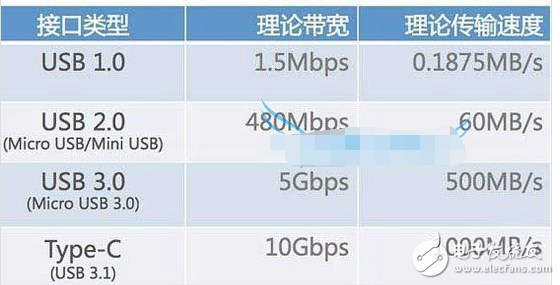**What is the USB-C Interface?**
USB-C, also known as USB Type-C, is a next-generation interface that belongs to the USB 3.0 family. It offers several advantages over its predecessors, such as a slimmer design, faster data transfer speeds (up to 10 Gbps), and higher power delivery capabilities (up to 100W). One of its most convenient features is that it supports reversible plug-in, meaning you can insert it either side up—no more guessing which way to plug it in. This makes it more user-friendly compared to older USB 2.0 or USB 3.0 ports.
USB-C was officially released in December 2013, and by August 2014, it was ready for mass production. It has since become widely adopted in modern smartphones, laptops, and other devices. For example, Apple’s 2015 MacBook 12-inch and the Nokia N1 tablet were among the first to use this interface, marking it as a key advancement in the evolution of USB technology.

**What Kind of Interface is USB-C?**
USB-C is a type of USB connection interface designed to be versatile and efficient. It measures approximately 8.3mm x 2.5mm, making it significantly smaller than traditional USB ports. It supports a wide range of functions, including standard charging, high-speed data transfer, and even display output. Developed by the USB Implementers Forum (USB-IF), USB-C gained popularity after being supported by major tech companies like Apple, Google, Intel, and Microsoft starting in 2014.
In 2015, several groundbreaking products with USB-C interfaces were introduced. Techco launched the world’s first USB-C portable SSD, while Tieweima introduced the first USB 3.1 Type-C disk array. Later that year, Teke Core Co., Ltd. unveiled the world’s first Type-C fingerprint-encrypted mobile SSD. These developments helped solidify USB-C as a leading standard in the industry.

**Key Features of the USB-C Interface:**
1. **Ultra-Thin Design**
The USB-C port is much smaller than traditional USB ports, measuring only 8.4mm x 2.6mm, compared to the 14mm x 6.5mm size of older USB-A ports.
2. **Reversible Plug-In**
Unlike previous USB designs, USB-C allows users to plug it in either way, eliminating the need to check the orientation before connecting.
3. **Fast Data Transfer**
With a maximum transfer speed of 10 Gbps, USB-C significantly outperforms USB 3.0, making it ideal for transferring large files quickly.
4. **Bidirectional Power Delivery**
Unlike older USB ports, which only allowed one-way power flow, USB-C supports bidirectional power transfer, enabling more flexible and efficient charging options.
5. **High-Power Charging**
USB-C cables can carry up to 3A of current and support the USB Power Delivery (PD) standard, allowing for up to 100W of power delivery—ideal for charging laptops and other high-power devices.
6. **Backward Compatibility**
While USB-C is a new interface, it is compatible with older USB standards through the use of adapters or dongles, ensuring continued usability of existing devices.
**The Difference Between USB 3.1 and USB-C**
USB 3.1 is a data transmission standard that supports speeds up to 10 Gbps. It is an industry-wide specification developed by companies like Intel. On the other hand, USB-C is a physical connector specification that defines the shape and pin configuration of the port.
USB 3.1 includes three types of connectors: Type-A, Type-B, and Type-C. While Type-C is often associated with USB 3.1 due to its advanced performance, they are not the same thing. A device with a USB-C port does not automatically mean it supports USB 3.1, and vice versa. The main difference lies in their purpose: USB 3.1 is about speed, while USB-C is about connectivity and versatility.
In summary, USB-C offers a more compact, reversible, and powerful interface, but whether it supports USB 3.1 depends on the specific device and its implementation.
Power+ Signal Power Connector
power connector is used in power module system. It can select the matching power + signal connector according to the need. The feature is that the number of power and signal contacts and the matching sequence can be selected arbitrarily while keeping the connector size and contact core number unchanged.
Plug (male) / socket (female) can be installed at 90 or 180 degrees. It supports mixed or independent combination of signal and power. The quantity range of power and signal is (2-16) pin and (12-128) pin respectively
Product features
High temperature resistant, glass fiber reinforced and flame retardant polyester is used as insulation material
Copper gold composite conductor with high conductivity is used, and the contact area of the conductor is plated with gold
It adopts shrapnel contact, which has the characteristics of integration, small volume, large current carrying capacity, soft plug-in, blind plug-in, self guidance and high dynamic contact reliability. This series of products can be interchanged with FCI's powerblade series and Tyco's multi-beam series
There are three sizes of center distance of power contact: 5.08mm, 6.35mm and 7.62mm
The length of power hole / signal pin can be selected in two sizes. The power rated current is 45A and the signal rated current is 2.5A
Power+ Signal Power Connector
ShenZhen Antenk Electronics Co,Ltd , https://www.antenk.com

